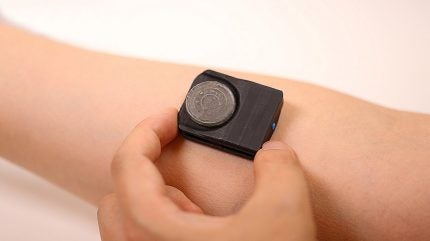
Northwestern University scientists in the US have developed a wearable skin health monitor device designed to measure gases both emitted from and absorbed by the skin, offering a skin health-evaluating approach.
The device is equipped with a suite of sensors that measure water vapour, carbon dioxide (CO₂), volatile organic compounds (VOCs), and temperature changes.
The device features a small chamber that captures gases without actually making contact with the skin, a crucial aspect for evaluating sensitive or damaged skin without causing further disturbance.
Northwestern noted that the skin’s outermost layer, known as the skin barrier, serves as the first line of defence against external threats. It helps retain moisture by stopping excessive water loss and protects from bacteria, harmful ultraviolet radiation, and irritants.
If this barrier is damaged, it can result in increased transepidermal water loss (TEWL), making the skin more sensitive and vulnerable, heightening the risk of infections, and contributing to inflammatory conditions.
Monitoring the water vapour and gas emissions from the skin can reveal the condition of this barrier, helping healthcare professionals understand issues.

US Tariffs are shifting - will you react or anticipate?
Don’t let policy changes catch you off guard. Stay proactive with real-time data and expert analysis.
By GlobalDataThis wearable device enables remote monitoring by physicians and allows individuals to manage their skin health at home.
According to the university, the device measures 2cm × 1.5cm, it includes a chamber, an electronic circuit, sensors, a programmable valve, and a rechargeable battery.
The valve’s automatic opening and closing allow for the capture and analysis of gas concentrations within the chamber.
Data from the device are transmitted to a smartphone or tablet via Bluetooth, providing real-time monitoring for healthcare workers.
This immediate feedback can lead to “informed” decisions in wound management and antibiotic administration.
For diabetic patients who require continuous wound monitoring, this technology could be particularly beneficial.
The Northwestern team is now working on enhancing the device by adding a sensor that can monitor changes in pH level and developing gas sensors with increased chemical selectivity to identify early signs of organ dysfunction and other diseases.
The development of this wearable skin health monitor was supported by the Querrey-Simpson Institute for Bioelectronics, the National Institute of Diabetes and Digestive and Kidney Diseases, and the Center for Advanced Regenerative Engineering.
According to the university’s study, the device’s efficacy has been demonstrated on both small animals and human subjects.
Northwestern dermatology and neurological surgery professor John A Rogers said: “This device is a natural evolution of our lab’s wearable electronic devices that collect and analyse sweat.”



